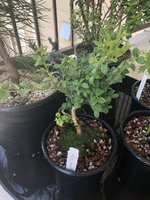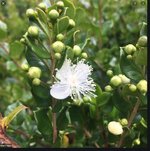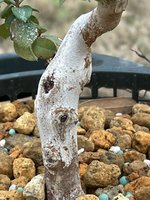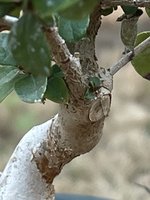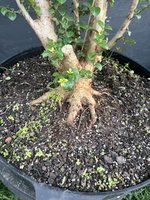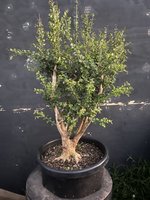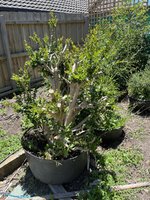Shibui
Imperial Masterpiece
In this thread https://www.bonsainut.com/threads/common-myrtle-as-bonsai.48555/Deep Sea Diver asked for photos of Luma apiculata.
Rather than posting in that thread I've started this one for anyone to add pics or anecdotes about this species.
I've had this species here for a few years and everything I have seen shows this is a great species for bonsai.
Small leaves
Easy to propagate - cuttings root quickly and reliably.
Relatively quick growing.
Sprouts from bare wood so great for trunk chops and fast growing to develop trunks.
Smooth, shiny bark.
Flowers.
Evergreen
Responds well to root pruning. I have reduced roots by 90% and the tree just bounces right back
Hardy in my climate. No sign of cold sensitivity down to -4C and up to 43C in summer
Tolerates shade. Possibly even grows better in shade
No pests or disease - yet
These are obviously very immature specimens. All 3 were chopped back hard last spring - 6 months ago. Pretty much all branches here have grown through summer. i tried to get the larger one I have used as a stock plant for cuttings but it has grown roots out through the bottom of the pot and is really well anchored into the ground so I could not move it today. I will cut it out in a month or so when the current dry weather has abated.
I'm trying to produce good shohin size bonsai from these 2. They have had a couple of hedge prune trims during summer but I have not looked at selecting branches to develop yet.

This next one went into a small bonsai pot and will be offered for sale if anyone fancies a small Luma apiculata mallsai. Growth definitely slows in a smaller pot but another one in a bonsai pot did flower this year.
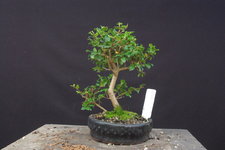
Any other experiences or thoughts on this or closely related species?
Rather than posting in that thread I've started this one for anyone to add pics or anecdotes about this species.
I've had this species here for a few years and everything I have seen shows this is a great species for bonsai.
Small leaves
Easy to propagate - cuttings root quickly and reliably.
Relatively quick growing.
Sprouts from bare wood so great for trunk chops and fast growing to develop trunks.
Smooth, shiny bark.
Flowers.
Evergreen
Responds well to root pruning. I have reduced roots by 90% and the tree just bounces right back
Hardy in my climate. No sign of cold sensitivity down to -4C and up to 43C in summer
Tolerates shade. Possibly even grows better in shade
No pests or disease - yet
These are obviously very immature specimens. All 3 were chopped back hard last spring - 6 months ago. Pretty much all branches here have grown through summer. i tried to get the larger one I have used as a stock plant for cuttings but it has grown roots out through the bottom of the pot and is really well anchored into the ground so I could not move it today. I will cut it out in a month or so when the current dry weather has abated.
I'm trying to produce good shohin size bonsai from these 2. They have had a couple of hedge prune trims during summer but I have not looked at selecting branches to develop yet.

This next one went into a small bonsai pot and will be offered for sale if anyone fancies a small Luma apiculata mallsai. Growth definitely slows in a smaller pot but another one in a bonsai pot did flower this year.

Any other experiences or thoughts on this or closely related species?

